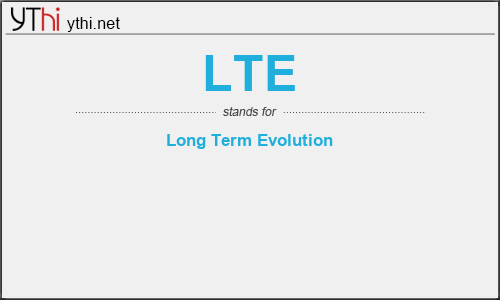What does LTE mean? What is the full form of LTE?
The full form of LTE is Long Term Evolution.
LTE is a first-generation 4G (4th generation) cellular networking technology based on original 3G (3rd generation) technologies that can reach speeds of around 100Mbit/s, reduced latency, scalable bandwidth capacity, and backwards compatibility with existing GSM and UMTS technology. GPP engineers named the technology “Long Term Evolution” because it represents the next step (4G) in a progression from GSM, a 2G standard, to UMTS, the 3G technologies based upon GSM.
The upper layers of LTE are based upon TCP/IP, and support mixed data, voice, video and messaging traffic. LTE uses OFDM (Orthogonal Frequency Division Multiplexing) and, in later releases, MIMO (Multiple Input Multiple Output) antenna technology similar to that used in the IEEE 802.11n wireless local area network (WLAN) standard.
Further evolution steps will be taken within a few years, with 5G (5th generation) scheduled to be released around 2020/2021, or possibly earlier. Each generation seems to have about a 10 year span between releases.
LTE is the current 4G cell phone technology. Most modern smartphones use LTE with a fallback to 3G systems where LTE is not available. LTE uses OFDM with QAM modulation in 10 or 20 MHz channels along with MIMO to provide downlink data rates of up to 150 Mb/s. More recent versions such as LTE-Advanced and LTE-Advanced Pro use carrier aggregation (CA) to widen the bandwidth by combining up to 32 channels to achieve 100 MHz or more of bandwidth to get even higher speeds. With the right combination of CA, 256-QAM and 4 × 4 MIMO, LTE can achieve data rates up to 1 Gb/s.
The advanced versions of LTE-A also use unlicensed spectrum to further increase bandwidth. Features such as Licensed Assisted Access (LAA), LTE-WLAN (LWA), and LTE-U for unlicensed combine LTE spectrum and the unlicensed 5 GHz spectrum used by Wi-Fi 802.11ac/ax to boost downlink speed.
LTE-A Pro adds IoT/M2M connectivity (see Chapter 9). LTE-M uses only 1.4 MHz of bandwidth to achieve speeds up to 1 Mb/s. An ever more frugal version called NB-IoT uses 180 kHz to achieve a data rate to 250 kb/s. These new versions use less power and will find applications in IoT and in vehicle-to-everything (V2X) applications such as the advanced driver assistance systems (ADAS) and self-driving cars.
LTE Advanced also provides for a feature called device-to-device (D2D) communications. It lets LTE handset users talk directly to one another rather than through a cell site. Public safety officials are expected to adopt this version of LTE in lieu of more traditional two-way radio technologies.
LTE is the dominant worldwide cell phone technology. Many cellular operators are still up grading to the advanced versions. LTE works well and satisfies most of the demands of subscribers. However, the future is expected to require even faster networks. For that reason, the 5G technology is under development.
Long-term evolution (LTE) is the de facto fourth generation of cellular radio network that is defined by the Third Generation Partnership Project. Although LTE is a centralized architecture (similar to previous generations of cellular radio network systems and does not have a native ad hoc mode such as IEEE 802.11p), LTE serves as a potential access technology for vehicular communication networks for several reasons. It has very high data rates (>100 Mb/s), which makes it suitable for so-called “infotainment” (information and entertainment) vehicular applications. LTE can tolerate high mobility and has low transmission latency. Both of these attributes are particularly important for road safety applications. Further, LTE can cover a much wider area and has higher penetration rate than IEEE 802.11p. Major telecommunication carriers are heavily investing in LTE infrastructure and have already deployed it in some markets around the world. LTE is a promising technology that can complement some of the major gaps with IEEE 802.11p, which are due to intermittent coverage and lower penetration rate. Major stakeholders are experimenting with the LTE technology for specific road safety applications and traffic efficiency messaging such as reporting nearby road hazards and traffic alerts to large coverage areas.
LTE
means
Long Term Evolution![]()
Translate Long Term Evolution to other language.


Leave a Reply
You must be logged in to post a comment.